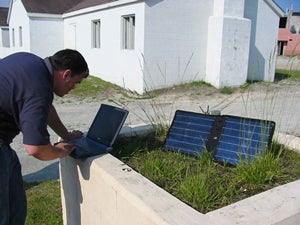Telemedicine proves its worth in disasters
GREENVILLE, N.C. (Sept. 16, 2002) — Three years ago this week, as Hurricane Floyd neared land, eastern North Carolina braced for what would become the state’s worst natural disaster. But out of that disaster were born new ways to use technology to communicate when old-fashioned telephone lines are jammed or out of commission.
The Telemedicine Center at East Carolina University is at the forefront of these advanced communication technologies, using them to transmit not only words but also pictures, health data and other information that could prove vital the next time a natural disaster or terrorist threat occurs.

Tim Murphy, an ECU Telemedicine Center engineer, tests a solar-powered wireless video camera and notebook computer during the May 31-June 1 bioterrorism exercise. Photo courtesy ECU Center for Health Sciences Communication.
“In a major disaster, whether it’s a hurricane or terrorist attack, the communications network can be quickly overwhelmed,” said Scott Simmons, director of design and development engineering at the Telemedicine Center. “That’s why you need redundant, fault-tolerant communications as well as rapidly deployable systems” such as satellite communications.
Telemedicine, the use of two-way telecommunications technology, multimedia, and computer networks to deliver or improve health care, is a growing trend internationally, with the United States, Canada, the United Kingdom and Scandinavia among the leaders in the field. Simmons is part of a team at the Telemedicine Center that’s packaging technology in such a way that it fills communications needs while also monitoring for toxic agents, transmitting health details of injured people and communicating other data.
For instance, devices that monitor for deadly sarin gas can be paired with global-positioning devices to pinpoint the exact location of a toxic cloud. Add satellite telephones, and that information can be delivered anywhere in the world, regardless of the condition of telephone lines or radio towers, which could be destroyed in a terrorist attack or natural disaster.
Toss in portable diagnostic equipment that can monitor heart rhythms, give close-up views of skin injuries such as burns or rashes and perform other patient assessments, and experts at medical centers such as the Brody School of Medicine at ECU can quickly relay life-saving information back to emergency workers at the front lines.
The practice of medicine through telecommunications began in the early 1960s when the National Aeronautics and Space Administration first put men in space. Physiological measurements of the astronauts were beamed down from spacecraft and space suits during space flights. These early efforts improved with the development of satellite technology, which led to telemedicine.
In the past 10 years, telemedicine has taken advantage of the boom in computer, video and telecommunications technology to become much more comprehensive. Using diagnostic equipment with tiny cameras, automated blood pressure cuffs and other devices, clinicians can accurately assess a patient many miles, or even continents, away. Since 1992, the Telemedicine Center at ECU has supported more than 7,500 telemedicine consultations in more than 35 medical specialties. Most of these have involved patients who were not in a position to travel to a major medical center for evaluation.
The technology also is a useful teaching tool. Since 1992, the center has conducted more than 10,000 distance learning and continuing medical education activities.
The center has also participated in regional, national and international demonstrations and drills showing that telemedicine has capabilities far beyond just allowing a dermatologist at a medical school to consult on a rash on a patient in a rural clinic. High-speed Internet, wide-area networks, mobile computing and wireless technologies enable telemedicine to be much more widely distributed, Simmons said.
Experts from the Telemedicine Center recently put their ideas to the test when they joined members of the military and civilian emergency.